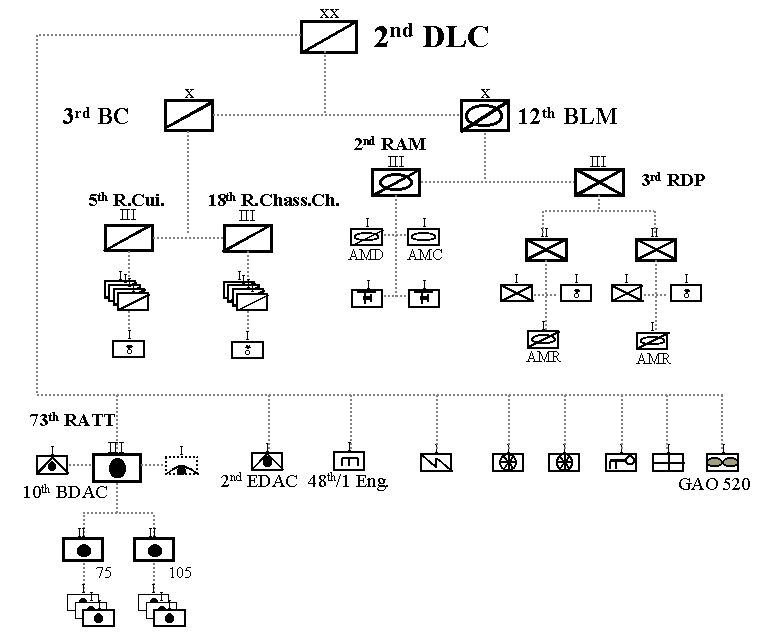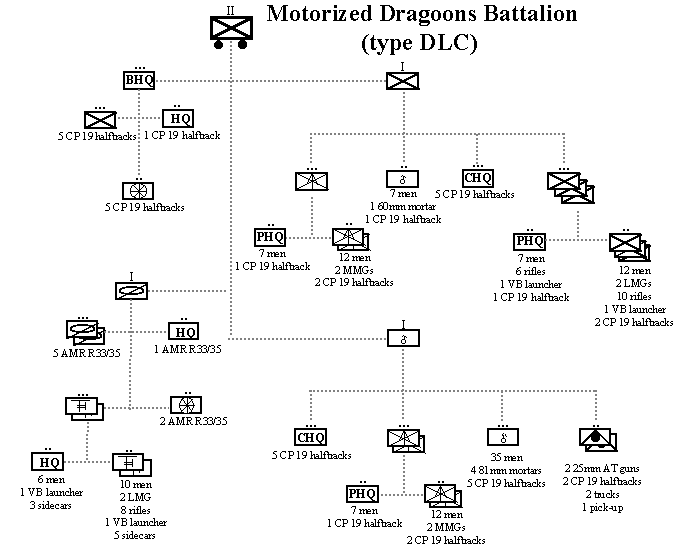
During the summer 1939, the Cavalry Inspectorship and General Gamelin wanted to change the composition of the Cavalry Divisions. It was judged that the Cavalry Division had too many horses which were vulnerable to air attacks and was ill-equipped to fight tanks. Also, in the event of a new war, there was no area where to use the Cavalry units between the Maginot and Siegfried lines. Therefore, it was decided to lighten these formations. Such a measure would free soldiers to reinforce Light Mechanized Divisions and Reconnaissance Battalions for the Infantry Divisions. The New Light Divisions would be used in rough and/or wooded areas where horses were particulary suitable. The Ardennes and Swiss frontier therefore appeared areas where to deploy and use these new formations.
When the war broke out, the 3 last Cavalry Divisions were mobilized but the Phony War allowed the French Army to transform these divisions into 5 Light Cavalry Divisions in February 1940.
| 1st DLC | 2nd DLC | 3rd DLC | 4th DLC | 5th DLC | |
| Cavalry Brigade:
- Cavalry regiment - Cavalry regiment |
2nd BC
1st Chasseurs 19th Dragoons |
3rd BC
18th Chasseurs 5th Cuirassiers |
5th BC
4th Hussards 6th Dragoons |
4th BC
8th Dragoons 31st Dragoons |
6th BC
11th Cuirassiers 12th Chasseurs |
| Light Motorized Brigade:
- 15 H-35/39 - 16 AMD Panhard178 - 23 AMR 33/35 |
11th BLM
1st RAM 5th RDP |
12th BLM
2nd RAM 3rd RDP |
13th BLM
3rd RAM 2nd RDP |
14th BLM
4th RAM 14th RDP |
15th BLM
5th RAM 15th RDP |
| Artillery Regiment:
- 12 75mm guns - 12 105mm howitzers - BDAC (8 47mm AT guns) |
75th RATT 10th BDAC |
73rd RATT 10th BDAC |
72nd RATT 10th BDAC |
77th RATT none |
78th RATT 10th BDAC |
All 5 DLCs, together with 3 cavalry brigades, were
to advance into the Ardennes area to delay a potential German move. They
were assigned objectives along the Belgian border. 1st DLC and 4th DLC
were assigned to IXth Army, 2nd DLC and 5th DLC were assigned to IInd Army
and 3rd DLC was assigned IIIrd Army. This deployment would prevent the
DLCs from having a coherent action in front of the leading German units.

The Light Cavalry Division was built around 2 brigades: one light motorized
brigade and one cavalry brigade.
The Cavalry brigade comprised 2 cavalry regiment (roughly, a cavalry
regiment was the equivalent of an infantry battlion in terms of men).
The Light Motorized Brigade had a Motorized Dragoons Regiment and a
Regiment of Armored Cars.
The Artillery Regiment had two groups of 12 75mm guns and a group of
12 105mm howitzers, as well as a 47mm AT gun battery (2 platoons of 4 guns
each) and a 25mm AA battery (6 guns) but only the 5th DLC would receive
its AA battery (715/409 Bie) by the end of May 1940.
The Régiment de Dragons Portés (RDP) had 2 battalions (the first battalion had CP 19 unarmoured halftracks while the second battalion had usually regular trucks).

Each battalion had only 3 squadrons:
- 1 squadron of AutoMitrailleuses de Reconnaissance (AMR) with 1 command AMR, 2 platoons of 5 AMR each and 2 motocyclists platoons. Each motocyclists platoon had a command squad of 6 men (with 1 VB rifle grenadier) and two combat squads of 10 men with 2 LMGs and 1 VB rifle grenadier each, transported by 13 side-cars (one for two men).
- 1 squadron of riflemen with 3 combat platoons and 1 MG platoon. The combat platoon had 7 CP19 unarmoured halftracks with one command squad of 7 men (with 1 VB rifle grenadier) and 3 combat squads transported each into 2 CP19 halftracks with 6 men and 1 LMG each (the combat squad had 1 VB rifle grenadier). The MG platoon had 5 CP19 halftracks with 4 MMGs (6-men crew) and a command squad of 7 men. In addition to these platoons, the riflemen squadron had 1 60-mm mortar (7-men crew in one CP19 halftrack) and a command platoon of 30 to 40 men with the 5 remaining CP19 halftracks. Therefore, the riflemen squadron had about 200 men with 32 CP19 unarmoured halftracks, 18 LMGs, 12 VB rifle grenade launcher 4 MMGs and 1 60mm mortar.
- 1 squadron of Mitrailleuses et Engins (support company) with 2 MG platoons, one mortar platoon and two anti-tank groups. The MG platoon was equivalent to the one in the riflemen squadron with 5 CP19 halftracks and 4 MMGs each. The mortar platoon had 5 CP19 halftracks with one command squad and 2 groups of 2 81mm mortars with 7-men crews each. The anti-tank group had 2 CP19 halftracks with two 25mm AT gun (8-men crew each). The anti-tank group also had 2 more trucks and 1 pick-up. In addition to these platoons, the support squadron should have a command platoon with 4 more halftracks. Therefore, the support squadron had 19 CP19 unarmoured halftracks, 8 MMGs, 4 81-mm mortars and 4 25mm AT guns.
Therefore, a motorized dragoons battalion had 11 AMRs, 26 LMGs,24
VB rifle grenade launchers, 12 MMGs, 1 60mm mortars, 4 81mm mortars and
4 25mm AT guns
(by comparison, a regular infantry battalion had 36 LMGs, 48 VB
rifle grenade launchers, 16 MMGs, 3 60mm mortars, 2 81mm mortars and 2
25mm AT guns)
The Motorized Dragoons Battalion (type DLC) was a surprising unit with a lot of heavy weapons (like AMRs, MMGs, mortars and AT guns) and the equivalent of an infantry company in terms of riflemen squads (13 squads as opposed to 12 for the infantry company).
The Régiment d'AutoMitrailleuses (RAM) had 4 squadrons:
- 1 squadron of AutoMitrailleuses de Découverte (AMD) with 1 command AMD, 4 platoons of 3 AMDs each and 2 AMDs in reserve. (the last AMD was for the regiment commander)
- 1 squadron of AutoMitrailleuses de Combat (AMC) with 1 command AMC, 4 platoons of 3 AMCs each and 2 AMCs in reserve.
- 2 squadrons of motocyclists with 4 platoons each. Each platoon had a command squad of 6 men (with 1 VB rifle grenadier) and two combat squads of 10 men with 2 LMGs and 1 VB rifle grenadier each, transported by 13 side-cars (one for two men). In addition to the 4 platoons, the squadron had 1 60mm mortar (4-men crew on 2 side-cars) and a command platoon of 30 to 40 men with a few vehicules (2 trucks, 4 pick-up and 2 cars).
Therefore, a RAM had 16 AMDs, 15 AMCs, 16 LMGs, 24 VB rifle grenade launchers and 2 60mm mortars
Each cavalry regiment had 5 squadrons:
- 4 cavalry squadrons with 4 combat platoons. Each combat platoon had 36 men: one command squad of 4 men, 2 combat squads and 1 scouts sub-squad. Each combat squad (13-men strong) had 2 sub-squads of 6 men each: 1 scout sub-squad (with 1 VB rifle grenadier) and 1 LMG sub-squad. Therefore, the cavalry squadron had only 8 LMGs.
- 1 squadron of Mitrailleuses et Engins (support company) with 2 MG platoons, one mortar platoon and two anti-tank groups. The MG platoon has 4 MMGs. The mortar platoon had one command squad and 2 groups of 2 60mm mortars with 7-men crews each. The anti-tank group had 2 25mm AT gun (8-men crew). The anti-tank group also had 2 more trucks and 1 pick-up. In addition to these platoons, the support squadron should have a command platoon. Therefore, the support squadron had 8 MMGs, 4 60-mm mortars and 4 25mm AT guns.
Therefore, a cavalry regiment had 32 LMGs, 48 rifle grenade launchers,
8 MMGs, 4 60mm mortars and 4 25mm AT guns
(by comparison, a regular infantry battalion had 36 LMGs, 48 rifle
grenade launchers, 16 MMGs, 3 60mm mortars, 2 81mm mortars and 2 25mm AT
guns)
Although the DLCs had been badly maulded during May, the quality of the men serving in the DLCs allowed these units to retain some cohesion and combat effectiveness despite heavy losses.
The 1stDLC, together with GRDI 24, GRDI 30 and GRCA
17, managed to reach the Frontier Line in the Trelon area although the
1st RAM and the 5th RDP were nearly destroyed. On May, 16th, the unit was
releaved by the 1st DINA and sent south in the Compiègne area for
replacement. The 1st DLC would then be converted into the 4th DLM.
The 4th DLC would cover the rereat of the II CA
over the Sambre at Labuissière. The unit would then be transfered
to Cambrai and Amiens for rest and replacement. The 4th DLC would then
be converted into the 7th DLM.
After their unsuccessfull employment in the Ardennes,
the 2nd DLC, the 3rd DLC and 5th DLC were sent to the Somme to cover the
left wing of the French Army still forming. They arrived in the Abbeville
area from May, 23rd to 25th for the motorized elements,and on May, 29th,
for the cavalry elements. Their losses in the Ardennes forest had not yet
been replaced: the 2nd DLC had lost half of its AMDs and AMRs as well as
500 men, the 3rd DLC had lost half of its AMDs and the 5th DLC had lost
half of its armor, 1000 men, 4 75mm guns, 4 105mm howitzers and most of
its 25mm AT guns. The Hotchkiss of the 3rd DLC would never arrive to the
Somme due to numerous mechanical breakdowns. The 2nd DLC and 5th DLC would
be thrown into the Abbeville battle. When the Germans would attack on June
5th, 1940, both the 2nd DLC and 5th DLC were still in line on the Somme
river. The 3rd DLC was held in reserve. At that time, these 3 DLCs had
less than 60 armored vehicles instead of 165.
Back to Homepage